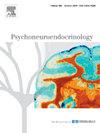青少年接触柴油相关颗粒物、皮质醇应激反应性和抑郁症状
IF 3.4
2区 医学
Q2 ENDOCRINOLOGY & METABOLISM
引用次数: 0
摘要
暴露于空气污染与较高的精神病理学风险有关;然而,这种关联的机制尚不清楚。应对压力的下丘脑-垂体-肾上腺(HPA)轴功能障碍与抑郁症有关联。在此,我们利用 170 名 9-15 岁青少年(56% 为女性)的住址和附近监测点的数据,估算了他们每年暴露于柴油机排放的颗粒物(PM)的情况。我们在参与者完成一项社会压力任务时采集了他们的唾液皮质醇样本,并计算了相对于地面的曲线下面积(AUCg)和相对于上升的曲线下面积(AUCi),以评估压力期间皮质醇的反应性。参与者还报告了他们的抑郁症状和睡眠障碍。暴露于柴油机 PM 的程度越高,应激时皮质醇的输出量(AUCg)就越低,而应激时皮质醇的输出量越低,青少年的抑郁症状就越重,尤其是睡眠障碍较严重的青少年。重要的是,这些影响与家庭和社区的社会经济劣势以及早期逆境暴露无关。因此,HPA 轴功能障碍可能是环境污染物影响青少年心理健康的一种机制。本文章由计算机程序翻译,如有差异,请以英文原文为准。
Exposure to diesel-related particulate matter, cortisol stress responsivity, and depressive symptoms in adolescents
Exposure to air pollution is associated with higher risk for psychopathology; however, the mechanisms underlying this association are not clear. Dysfunction of the hypothalamic-pituitary-adrenal (HPA) axis in response to stress has been implicated in depression. Here, we estimated annual exposure to particulate matter (PM) from diesel emissions in 170 9- to 15-year-old adolescents (56 % female) using their residential addresses and data from nearby monitoring sites. We obtained salivary cortisol samples from participants while they completed a social stress task and calculated area under the curve with respect to ground (AUCg) and with respect to increase (AUCi) in order to assess cortisol responsivity during stress. Participants also reported on their depressive symptoms and sleep disturbances. Greater exposure to diesel PM was associated with lower cortisol output (AUCg) during stress, which was associated with higher depressive symptoms, particularly for adolescents with more sleep disturbances. Importantly, these effects were independent of household and neighborhood socioeconomic disadvantage and exposure to early adversity. Thus, HPA-axis dysfunction may be one mechanism through which environmental pollutants affect adolescents’ mental health.
求助全文
通过发布文献求助,成功后即可免费获取论文全文。
去求助
来源期刊

Psychoneuroendocrinology
医学-精神病学
CiteScore
7.40
自引率
8.10%
发文量
268
审稿时长
66 days
期刊介绍:
Psychoneuroendocrinology publishes papers dealing with the interrelated disciplines of psychology, neurobiology, endocrinology, immunology, neurology, and psychiatry, with an emphasis on multidisciplinary studies aiming at integrating these disciplines in terms of either basic research or clinical implications. One of the main goals is to understand how a variety of psychobiological factors interact in the expression of the stress response as it relates to the development and/or maintenance of neuropsychiatric illnesses.
 求助内容:
求助内容: 应助结果提醒方式:
应助结果提醒方式:


